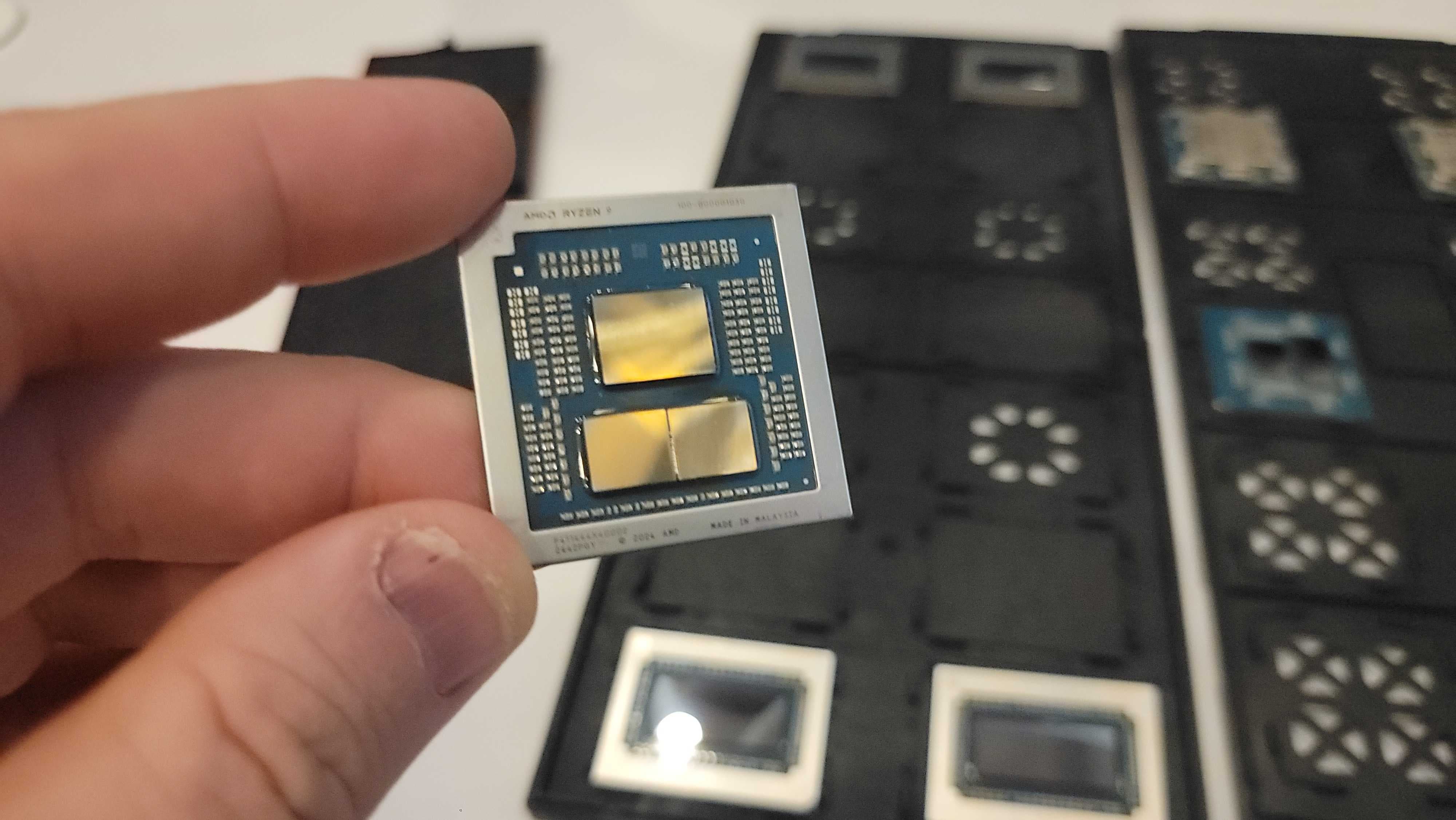AMD says Intel's 'horrible product' is causing Ryzen 7 9800X3D shortages
Team Blue in the rearview.

At a small roundtable session with AMD executives at CES 2025 in Las Vegas, we asked the company for details about continuing shortages of its flagship gaming-optimized Ryzen 7 9800X3D — currently the uncontested best CPU for gaming — and when we can expect the supply to improve. AMD chalked it up to unprecedented demand and noted that Intel's "horrible" product, also known as Arrow Lake, has led to wildly increased demand that has pushed far beyond initial projections. In a separate roundtable, I also had the chance to ask Intel about its plans to fire back at AMD's dominating 3D V-Cache processors.
"We knew we built a great part. We didn't know the competitor [Intel] had built a horrible one," quipped AMD executive Frank Azor. "So the demand has been a little higher than we forecasted."
It's no secret that Intel's Arrow Lake delivered underwhelming gaming performance at launch. Although the company has promised a 'fix' for the issue, we recently tested the full and complete patch on multiple systems. We found the patch does nothing to help (at least on two motherboards) and that the newer Windows revision required for the fix has benefited competing processors more, thus making Intel's Arrow Lake competitive positioning even worse than at launch. We'll publish that testing soon.
All of this means that Intel is far less competitive than AMD anticipated. That's exacerbated the longer-than-normal lead time for building an X3D processor. Due to the long lead times associated with building modern high-end processors, forecasting demand is key. Now that demand has far outstripped the original production targets, the company is cranking higher production into gear— but that takes time to filter down to the retail market.
"We have been ramping our manufacturing capacity, or the monthly, quarterly output of X3D parts, period, and that's 7000 [series] as well as 9000X3D," said AMD executive David McAfee. "It's crazy how much we have increased over what we were planning. I would say the demand we've seen for the 9800X3D and the 7800X3D has been unprecedented. So the demand has been higher than ever."
"Building a traditional semiconductor, it's basically 12 to 13 weeks from when you start a wafer to when you get a product out the other end of the machine," McAfee explained. "The [3D V-Cache] stacking process adds time to that, and so it's longer than a quarter horizon [three months] to really ramp output of those products. And so we're working very, very hard to catch up with demand. I think as we go through the first half of this year, you'll see us continue to increase the output of X3D. There's no secret, X3D has become a far more important part of our CPU portfolio than I think any of us would have predicted a year ago. And I think that trend will continue in the future, and we are ramping capacity to ensure we catch up with that demand for as long as customers want those X3D parts."
McAfee said there isn't any particular component or part of the production flow creating the bottleneck.
Get Tom's Hardware's best news and in-depth reviews, straight to your inbox.
"It's the problem that you've got that lead time to build individually the CCD wafer, the cache wafer, and then the stacking process that follows that, which also adds a considerable amount of time. It's a non-trivial timeline when you're talking about building X3D products."
McAfee also said new 99x0X3D products won't help spread the demand, as customers choose the 8-core X3D parts 10-to-1 over the higher core count X3D models.
"If I look historically at our 7000X3D products, the 70800X3D was dramatically the highest volume part in that product stack. I think that for those 12- and 16-core parts, there are certain types of customers that buy those. But I think the reality is if you are truly a creator, you probably still buy the 9950X. The X3D doesn't add much at all for creator workloads. [...] It's like a percentage of incremental performance by having the X3D there." McAfee said.
"My belief is, in the 9000 series, those higher core count products, there'll be some demand there, but it'll still be 10-to-1, or more, on the eight-core X3D parts because they're just such a great gaming part for a pure gamer, there's nothing else like it," he finished.
So now it's a waiting game. AMD has ramped production, but it will take some time for the flood of shiny new 9800X3D chips to come to market. By the time more units arrive, we'll likely see the new 9950X3D and 9900X3D landing on shelves as well.
As for Intel, it has been entirely incapable of answering AMD's 3D V-Cache technology — and for an extended period of time. I spoke with Intel about its plans at a separate roundtable.
"AMD has been executing with its stacked 3D V-Cache X3D processors for three generations now. They're integrating it into more and more products, bringing it to mobile, etc., and we expect that trend to continue," I said. "Intel has really not responded to that at all, at least in any way that we can see from the outside looking in. That's effectively ceding that high-margin, premium-tier gaming segment to AMD wherever they choose to deploy that technology. What are you considering as a response to this?" I asked.
"Our goal is that leadership product in every segment, and I'm not going to talk about unannounced products," replied Intel's Jim Johnson, Corporate VP and GM of Client Engineering.
With no official word on faster tech from Intel and no indications through leaks or other industry chatter that Intel has a new competing tech in the works, AMD will certainly continue to dominate the global gaming CPU market in 2025. For now, it is AMD's gaming world, and Intel is just living in it.

Paul Alcorn is the Editor-in-Chief for Tom's Hardware US. He also writes news and reviews on CPUs, storage, and enterprise hardware.
-
jp7189 "Our goal is that leadership product in every segment, and I'm not going to talk about unannounced products,"Reply
Welp.. good to have goals I guess... better to have an execution plan.
I still have this feel that the old salt Intel folks haven't the slightest clue how to compete from behind. -
saunupe1911 Ok well make more AMD because your stock isn't looking good right now!!!!!!!!!! It's a new year. Make adjustments.Reply
I absolutely hate when companies don't meet demand when their competition is down. It's time to eat! -
dimar AMD can skip the packaging and ship the CPUs in a clear plastic wrap. I'd like the sticker though.Reply -
georgebaker437 The moral of this story is..... Don't let MBAs make engineering decisions. Don't let (Boer) engineers make political decisions either!Reply -
hotaru251 amd: "Intel please...do soemthing big as we can't keep carrying cpu industry as we only got so many chips!"Reply -
helper800 Reply
Silicon allocation is purchased months to years in advance, its not something you can solve with a flick of the wrist.saunupe1911 said:Ok well make more AMD because your stock isn't looking good right now!!!!!!!!!! It's a new year. Make adjustments.
I absolutely hate when companies don't meet demand when their competition is down. It's time to eat! -
Alvar "Miles" Udell I highly doubt this for at least three reasons:Reply
One is that at 4K, as we know, the CPU doesn't really matter (using TPU's chart because TH didn't do a 4K test on the 9800X3D review, likely because it'd be a waste of time)
https://tpucdn.com/review/amd-ryzen-7-9800x3d/images/relative-performance-games-38410-2160.png
Two is that even at 1920x1080 and given an unrestricted GPU (the 4090 in this case), even AMD's first X3D CPU, not to mention Intel's 14700K and Ultra 265K, are capable of averaging 120fps, and last generation X3DS chips providing minimum 120fps, while the 9000X3D series are incapable of 240fps, and I'm willing to be the vast majority of monitors are 144hz or less.
https://cdn.mos.cms.futurecdn.net/UacqtYWFJGCCzZSuS553nV-1200-80.png.webp
And three is that the vast majority of people are using GPUs substantially weaker than the RTX 4090 and are far more GPU limited than CPU, and a CPU upgrade to the 9000X3D would not make a performance difference without a much more expensive GPU upgrade. -
thestryker It's always funny when the companies take shots at each other like that, because the first thing I thought was "and how's the 9000 series been selling for you?". I don't think anyone sensible thought that Intel could compete with an X3D part at gaming. Everyone looking at peak gaming performance also took one look at the 9000 series and went "well those can't compete with the 7800X3D" and moved along.Reply
If what you primarily do is gaming the X3D parts have proven to be the best buy of each generation because they're going to be the fastest and last longer. Someone who buys a 9800X3D today is probably not going to see it outperformed by a standard CPU for another two generations.